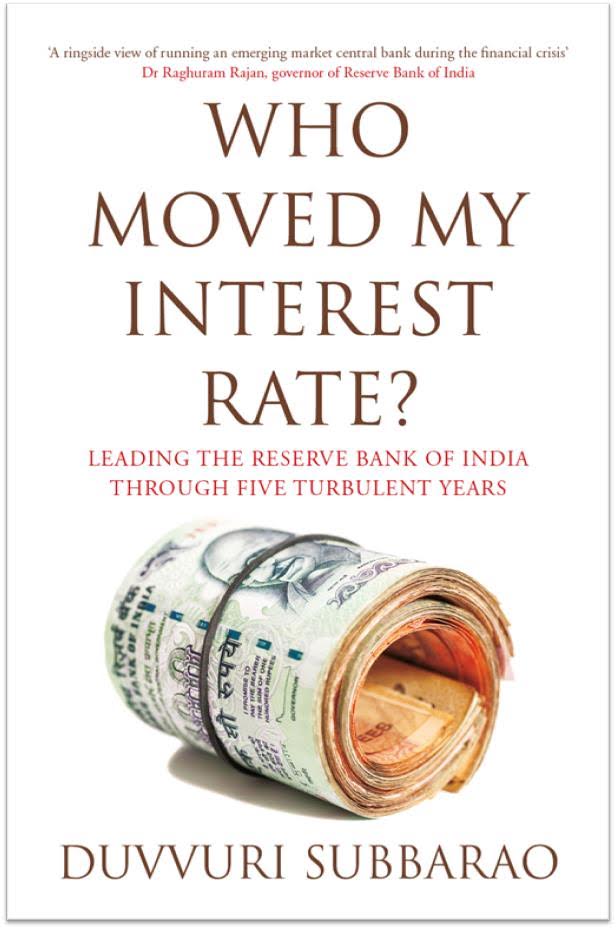By Meghna Mittal
Title: Who Moved My Interest Rate?; Author: Duvvuri Subbarao; Publisher: Penguin Random House India; Pages: 308; Price: Rs 525
It’s no secret that the equation between the Reserve Bank of India (RBI) and the government of the day has often been ticklish. But seldom has that been reflected openly — and certainly not in a book where the actors have been identified and their stands spelt out.
 But Duvvuri Subbarao’s book “Who Moved My Interest Rate” gives a candid, lively account of his interactions with the government, ministers, bankers and the media when he was the RBI Governor during the turbulent years for the global economy between 2008 and 2013.
But Duvvuri Subbarao’s book “Who Moved My Interest Rate” gives a candid, lively account of his interactions with the government, ministers, bankers and the media when he was the RBI Governor during the turbulent years for the global economy between 2008 and 2013.
So much so, he does not shy away from naming some people like P. Chidambaram and Pranab Mukherjee when they were finance ministers, or even Manmohan Singh as the Prime Minister during Subbarao’s tenure. Their comments and Subbarao’s take — and misgivings — make for interesting reading.
It also somewhat reflects the unease one sees today with Raghuram Rajan in the governor’s seat.
“I have been asked several times if there was pressure from the government on setting interest rates. There certainly was, although the precise psychological mechanics of pressure would vary depending on the context, setting and personalities,” says Subbarao — a fact presumed earlier.
“Both Chidambaram and Pranab Mukherjee were piqued by the Reserve Bank’s tight interest rate policy on the ground that high interest rates were inhibiting investment and hurting growth,” he adds, while reflecting how this resulted his recommendations on his deputies being overturned.
He also refutes Chidambaram claim that the government and the RBI agreed on eight out of 10 policy actions. “I found that all through my tenure, the government was distinctly uncomfortable with the RBI raising interest rates and seemed convinced that monetary policy was choking growth.”
Subbarao also reflects on how he found some statements by Chidambaram, upset over the central bank’s refusal to cut rates, unusual and uncharacteristic – specifically over the minister’s statement: “If the government has to walk alone to face the challenge, we will walk alone.”
Then he faults the finance minister’s decision on a money supply panel without consumting him.
“Chidambaram clearly overstepped into the Reserve Bank turf as liquidity management is a quintessential central bank function. Not only did he not consult me, but he had not even informed me of this before the notification was issued.”
As ragards Mukherjee, Subbarao says he met him only twice on a one-to-one basis. But there was one incident in which he feels the current President, was, perhaps naive and wanted to claim some credit for what is otherwise in the domain of the central bank.
This was when, just ahead of a monetary policy review, Mukherjee told a group of industrialists that the Reserve Bank governor will have some good news for them. “This was most inappropriate and indiscreet,” says Subbarao.
Then, on Manmohan Singh, he says the rigid stand on interest rates and concerns over high fiscal deficit did irk him. But this, he adds, was conveyed to him not directly, but via C. Rangarajan, a former governor himself and chair of the Prime Minister’s Economic Advisory Council.
Nonetheless, Subbarao alludes, it was Manmohan Singh who ignored others for giving him a two-year extension.
The book is not about controversies alone. It is written in a simple format to give a peek into the life of a central bank governor, while also giving a ground-level account of how this coveted job is not about glamour alone.
The fact is Subbarao’s term from 2008-13 was marked by continuous firefighting and dealing with global financial crisis, inflation and rupee depreciation, among other concerns. The book gives a candid account of how governments and the central banks want to deal with such concerns. (IANS)







